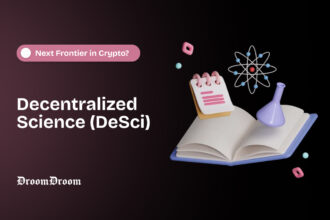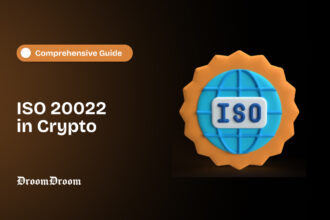Are you ready to join the thrilling realm of cryptos and explore how technology blends with economic landscapes? One major element powering such ventures is “tokenomics.” Though cool-sounding, it’s not a trend and, rather, is the lifeblood of a decentralized world.
- Why does Tokenomics Matter?
- Incentive Alignment
- Value Proposition
- Community Engagement
- Governance and Decision-Making
- Economic Sustainability
- Investor Confidence
- Scarcity and Demand
- Adaptability and Evolution
- How Do You Analyze Crypto-Tokenomics?
- Whitepaper Examination
- Token Distribution
- Utility and Use Cases
- Supply and Demand Dynamics
- Incentive Structures
- Governance Mechanisms
- Community and Development
- Market Trends and Sentiment
- Transparency and Communication
- How Does Crypto-Tokenomics Work?
- Token Creation
- Token Distribution
- Utility and Use Cases
- Supply and Demand Dynamics
- Incentive Structures
- Governance Mechanisms
- Community Engagement
- Adaptability and Evolution
- What Are The Key Elements of Tokenomics?
- Token Purpose
- Token Supply and Distribution
- Utility and Use Cases
- Governance Mechanisms
- Incentive Structures
- Token Burning
- Economic Models
- Community Engagement
- Adaptability and Evolution
- Transparency and Communication
- What Are The Benefits of Tokenomics?
- Incentivizing Participation
- Community Engagement
- Governance and Decentralization
- Value Creation
- Scarcity and Demand
- Sustainable Growth
- Liquidity Provision
- Adaptability and Evolution
- Transparency and Trust
- Global Accessibility
- Financial Innovation
- Token as an Asset
- What Are The Disadvantages of Tokenomics?
- Volatility
- Regulatory Uncertainty
- Market Dependency
- Incentive Misalignment
- Lack of Adoption
- Complexity and Understanding
- Security Risks
- Liquidity Challenges
- Overemphasis on Speculation
- Centralization Risks
- Lack of Standardization
- Environmental Concerns
- Market Manipulation
- Conclusion
Therefore, let us strap ourselves up and start exploring the complexities of tokenomics in crypto projects. We shall embark on a journey across the waters of decentralized finance, starting from the primal elements of coins all the way up to the complex ballet of supply and demand, toward a better comprehension of the impact digital assets make in the modern-day economic sphere. Are you ready for the decryption of tokenomics cryptophony?
Tokenomics is an economic system of creating, distributing, and supervising the use of tokens in any particular blockchain or cryptocurrency initiative. Tokenomics defines interactions between individuals and a digital asset within the ecosystem where they exist as a fused “token” and “economics.” Therefore, the term tokenomics represents an economic model that ensures both sustainability and balance in a blockchain project. Being important for investors, developers, and users to know, it determines the future sustainability and prosperity of the coin.
Why does Tokenomics Matter?
Tokenomics is the backbone of crypto projects. It is like the circulatory system, which makes everything possible for living organisms. Here’s why it matters:
Incentive Alignment
Tokenomics brings together the interests of different stakeholders in the ecosystem. If you are a developer, investor, or user, realizing how they are distributed and why you should hold or use them in a collaborative environment is a good foundation for stability among stakeholders.
Value Proposition
The value of tokens arises from their utility, and, in combination with limited supply, the concept of tokenomics determines what the meaning of this token is within an ecosystem that gives it a real value and purpose for users to interact with a certain project.
Community Engagement
An appropriate system of tokens promotes a healthy population. Instead of mere users, they are active agents with an interest that goes beyond the scope of being mere spectators. This is important for the success and sustainability of crypto ventures.
Governance and Decision-Making
Several projects adopt community-driven token governance models. Tokenomics defines decision-making within the project and provides the holders of tokens with power. However, this represents an important characteristic in most blockchain projects since it constitutes its key factor.
Economic Sustainability
This is possible because tokenomics guarantees the economic viability of the project. It defines how tokens will be produced, distributed, and applied, making them stable for market changes and externalities.
Investor Confidence
Tokenomics is very important, as investors always carefully examine it before deciding on an investment. One must have a transparent and planned-out tokenomics approach to build trust. It lets users understand where the project will be creating and allocating value in the future.
Scarcity and Demand
Tokenomic also determines the scarcity of tokens, thereby influencing supply and demand dynamics. The design of a well-thought-out tokenomic is capable of creating a shortage, which eventually leads to a rise in the token’s value.
Adaptability and Evolution
Just like any other aspect of a project, tokenomics is also not static. When the ecosystem grows and becomes mature enough, tokenomics can then be adopted, following the new necessities of the communal environment and the set objectives of the project.
Tokenomics defines an essential framework for the entire economy surrounding a cryptocurrency endeavor. The success and sustainability of any blockchain initiative depend on the critical issues surrounding its thorough analysis and constant improvement.
How Do You Analyze Crypto-Tokenomics?
Investigating crypto-tokenomics is an all-encompassing process that touches on all dimensions of the venture. Here’s a guide to help you navigate this intricate terrain:
Whitepaper Examination
Know the value of the token as part of the system. Is it about ownership, management, benefits, or anything else? Examine how tokens are minted. Are these operations conducted through mining, staking, or ITOs?
Token Distribution
Investigate how tokens are offered originally. Is there someone with the highest number of coins, and where do they come from? Ensure that you have vesting schedules for the founders, team members, and early investors. This makes sure that tokens are being slowly introduced and incentives are in harmony with long-run prosperity.
Utility and Use Cases
Establish if the token is worth using. What role does it play in the system? Do they enable users to enjoy certain options, voting privileges, or participate in delegation? Familiarize yourself with real-world case scenarios of the token. Is it addressing a problem and improving some characteristics of the system?
Supply and Demand Dynamics
Checking the market using the tokenomics equation What are the mechanisms by which the total number of tokens is handled, and what effect do they have on value? Determine how effective it is and its role in creating a scarcity of tokens.
Incentive Structures
Consideration of stakeholder staking and associated rewards What incentivizes users to maintain and lock up tokens? Also, have an idea of liquidity provision payments, if any. Do users get extra rewards for participating in token liquidity?
Governance Mechanisms
If it has something to do with governance, then try knowing the distribution of voting power. Does each token holder have a proportionate say in decision-making, and if so, who makes these decisions?
Community and Development
Assess the community’s health potential. As such, a vibrant community is an indication that a project is in good shape. Check out a timeline of the project’s growth. What, then, is its roadmap for future updates and expansions, if any?
Market Trends and Sentiment
Consider broader market trends. What are the implications of external forces on the tokenomics of the project? Utilize surveys, forums, and other forms of publicity tools to gauge community sentiment. A positive sentiment could also be a success factor for this project.
Transparency and Communication
Evaluate the transparency of the project. Is it easy to get reliable information, and is the team open with its intentions as well? Assess the appropriateness of various communication channels. How willing is the team to respond to queries from members of the community?
Through an extensive analysis of such components, you will have a complete idea of what tokenomics is in a project and how viable it is for that specific venture to prosper.
How Does Crypto-Tokenomics Work?
Tokenomics in crypto is simply a set of rules that explain how specific cryptocurrencies operate in their virtual economies. Here’s a breakdown of how crypto tokenomics typically works:
Token Creation
For example, in some blockchain networks, tokens are generated by miners who solve complex mathematical equations that verify transactions and earn them new tokens as rewards. Other projects employ a proof-of-stake consensus mechanism, in which participants put down a specific number of tokens as a guarantee to confirm transactions and receive more tokens as payments.
Token Distribution
The majority of projects have an Initial Coin Offering (ICO) system as a way of getting the money required to fund the project. In an ICO, investors will buy tokens at a fixed price while providing financial support to the project. Free tokens are given out via airdropping and bounties, where users receive rewards for certain duties or by promoting the project.
Utility and Use Cases
Governance rights are usually associated with tokens that help in protocol upgrades, parameter settings, or decision-making on the direction of the project. Access tokens can grant users access to certain tools that exist in an ecosystem. For instance, they could offer their services, such as granting users premium services, voting power, or some other special privileges, free of charge.
Supply and Demand Dynamics
Typically, tokenomics will involve means to regulate supplies of tokens to create a deficit. The inability of the token to cover its scarcity could lead to an escalation in demand and eventually influence the token’s value in the market. Some projects make use of token burning, in which part of the token is purposely taken out of circulation, thereby decreasing the total supply.
Incentive Structures
Additional tokens may be used to reward users who decide to hold and stake their tokens. Liquidity providers can be enticed into projects as a result of providing tokens and other financial assistance.
Governance Mechanisms
The token holders normally have a vote proportionate to the number of tokens they hold. The democratic nature of this governance structure ensures that the community takes control and has input on significant issues.
Community Engagement
Without a prosperous community, a project cannot succeed. They all enhance ecosystem health through active engagement, discussion, and cooperation.
Adaptability and Evolution
Tokenomics is not static. It may include updates to projects to meet changing markets, new technologies, communities’ views, etc.
These components aid in understanding how an economic model for a crypto project works. Tokenomics is a delicately designed mechanism that is meant to create a balanced environment while motivating users and ensuring the longevity of the entire project for successful operations.
What Are The Key Elements of Tokenomics?
Tokenomics consists of several elements that describe the inner workings of a currency’s tokens in its ecosystem. Here are the fundamental elements:
Token Purpose
So what is the main role of the token in the project? Is it a pure utility token? Governance token, incentive token, or what? Ether (ETH) stands as a utility token used in transactions and computations within the Ethereum platform.
Token Supply and Distribution
How many tokens can the system ever generate? The importance of understanding the total supply to assess scarcity. How are tokens distributed initially? How does it divide founders, investors, developers, and the community?
Utility and Use Cases
What does the token do within the network? Can they help in attaining features, governance functions, or staking? What is the practical issue that it solves, or is it an everyday function that we are talking about?
Governance Mechanisms
How does voting power get distributed among holders if the token comes with a governance feature? How are the decisions made in the ecosystem?
Incentive Structures
Motivate users to stock and stake their tokens. What benefits will you get from involving yourself in network events? How are liquidity providers rewarded? What is the incentive for liquidity providers?
Token Burning
Does the project incorporate a token-burning methodology? What is the process that the market takes to intentionally reduce tokens in circulation, and why is it employed?
Economic Models
Is the token design model inflationary or deflationary?
Community Engagement
Is there a strong community supporting this project? Do the communities support each other, or do they receive any community development encouragement from a third party?
Adaptability and Evolution
What if there are changes or upgrades within the project? How does tokenomics react to this? Therefore, what is the instrument for the evolution of the economic system over time?
Transparency and Communication
Does the project have transparency in its tokenomics? Is information easy to access, and does the team share its plan and decisions freely? To what extent do the project’s communication channels work towards informing and engaging the community?
Combined, these make up the economy of a cryptocurrency project. By examining each element, one can gain an overall grasp on what makes up the tokenomics, as well as how such tokenomics work towards fulfilling the objectives of the project and those of its community.
What Are The Benefits of Tokenomics?
The various advantages that tokenomics provides towards making crypto projects succeed and remain operational. Here are some key advantages:
Incentivizing Participation
Tokenomics offers an effective scheme for inducing customers’ involvement in running the economy. Those who contribute to the project’s expansion include, among others, the one staking, those giving liquidity, or in whatever way they can be helpful.
Community Engagement
A vibrant and engaged community stems from a good tokenomics structure. Token holders turn into stakeholders with high stakes that lead to active engagement, discussion, and collaboration.
Governance and Decentralization
Governance is also part of most tokenomics and allows token holders to have their say on certain decisions. Decentralizing this enhances participatory democracy.
Value Creation
Tokenomics is defined as that which creates value by defining the utility and use cases of tokens within the said ecosystem. This results in an increase in demand for tokens required to gain access to special functions, participate in governance, and enjoy other privileges associated with owning these tokens.
Scarcity and Demand
Scarcity is the most frequent feature of many tokenomics-modeled approaches, like token burning. The scarcity may create a demand, which will in turn affect the worth of the token in the future.
Sustainable Growth
They also strive towards creating a financially viable approach for the project known as tokenomicns. Through prudent management of token supply, rewards, and economic frameworks, projects can realize gradual growth in a controlled manner.
Liquidity Provision
Tokenomics usually involves incentives for providing liquidity to the project’s native token, which helps enhance its liquidity. In trading, liquidity is important because it can facilitate user engagement.
Adaptability and Evolution
To this end, a robust tokenomics model is built with the flexibility factor taken into consideration. It is flexible and will change as per the shifting demands of the project itself, technology, or other developments in the competitive market sphere.
Transparency and Trust
Clear tokenomics, normally explained in a project’s whitepaper, promotes transparency. This fosters trust among the public, investors, and users.
Global Accessibility
The project becomes globally accessible through tokenomics. People from all corners of the world can take part in transacting and contributing to the system, thereby making it less discriminatory.
Financial Innovation
Financial innovation and tokenomics, among others, happen in the crypto space, where they are practiced. It enables the project to explore new monetary models that, in turn, create new models of adding value and distribution.
Token as an Asset
In this case, tokenomics turns tokens into tradable and worthwhile assets. It can help attract a wide selection of people, which may include investors and traders, as well as those interested in benefiting from the realization of this project.
There are immense advantages. However, creating robust tokenomics entails constant redesigning and responding to the changing wants of a project and its members.
What Are The Disadvantages of Tokenomics?
Although tokenomics presents several advantages, it may also be accompanied by certain disadvantages and problems. listade. Here are some drawbacks associated with tokenomics:
Volatility
This is typical of cryptocurrency markets. Price volatility due to tokenomics, especially in low-liquidity projects, may pose significant risks for users as well as early or late investors.
Regulatory Uncertainty
Cryptocurrencies operate in an unpredictable regulatory environment that constantly evolves. Implementation of effectiveness could be impeded by legal or regulatory concerns relating to tokenomics.
Market Dependency
The market condition usually affects a tokenomics success a lot. The value of tokens can be affected by external factors like market sentiment or trends, not necessarily the fundamentals of the project.
Incentive Misalignment
Tokenomics also needs to be carefully done, for there is a possibility of aligning some shareholders who do not care about long-term goals with short-term gains.
Lack of Adoption
Tokenomics depends on the involvement of users. The utility and value of the token could be limited if the project does not manage to attract users or attain mainstream adoption.
Complexity and Understanding
Sometimes tokenomics could be complicated, and it will not be that easy for an ordinary user or investor to grasp the economic model. Ignorance creates the possibility of false analysis, with poorly founded decisions as the result. become a part of your team, ensuring excellent quality!
Security Risks
Tokenomics is supported by smart contracts that sometimes have vulnerabilities. Hacks and exploits lead to the loss of finances and damage the reputation of the project as security issues bring the risks attached to it.
Liquidity Challenges
Ensuring that a token has adequate liquidity is a daunting task. This liquidity problem can lead to increased volatility in prices and inconvenience for buyers or sellers of the tokens on such illiquid markets.
Overemphasis on Speculation
Many tokenomics models driven by speculative trading or price appreciation may appeal to investors who are only focused on the short term, undermining the project’s sustainability over time.
Centralization Risks
There are some problems with governance issues embedded in a tokenomics model of economics. Holding high percentages of the total can expose the project to centralization risks, assuming that only a few entities have the tokens.
Lack of Standardization
Due to this, it is important to mention that no one has established a consensus for the tokens’ design. Investors may have a hard time comparing various tokenomics models.
Environmental Concerns
Employing proof-of-work or any other energy-intensive consensus mechanisms may lead to environmental issues. This could be criticized and even cause a negative image in the public about the project.
Market Manipulation
Market manipulation is one of the major challenges facing cryptocurrency markets. If some measures are applied to the projects aimed at preventing market manipulation and they fail, it may result in price distortions that adversely affect tokenomics.
These shortcomings must be dealt with cautiously, transparently, and in terms of continuous adjustment towards better services. Projects must re-evaluate, revise, and adapt their tokenomics during the navigation of these challenging stages of development toward success.
Conclusion
Finally, looking under the hood of tokenomics in crypto projects reveals a rich weaving of economics and technological advancement. Tokenomics are more than frameworks; they act as the lifeblood that keeps circulating through the decentralized rhythm of blockchain networks. Tokenomics is everything about defining the reason for the tokens, the dance of supply and demand, and ultimately building up a successful project.
Tokenomics can be said to be a double-edged sword that offers various advantages, such as encouraging people’s involvement and enhancing social relations, thereby resulting in creating sustainable value. Nonetheless, it is not without its problems, such as market fluctuations, regulatory uncertainty,, and misaligned incentives.
However, it is exactly through overcoming these difficulties that there is room for novelty, persistence, and ceaseless enhancement. While crypto projects traverse through the labyrinthine terrain of tokenomics, they do so in a transparent manner, which shows flexibility and compliance are paramount.
To the future and beyond, the changing face of tokenomics does not just mean rewriting the financial textbooks; it’s also about crafting an entirely different way of working together economically! Tokenomics is more than a trip through the engine room of crypto; it’s a quest to find the transformational power of distributed economics. Therefore, as an investor, developer, or fan, this journey into the world of tokenomics is continuous. Every project becomes a new chapter in the unfolding narrative of the crypto world.



















